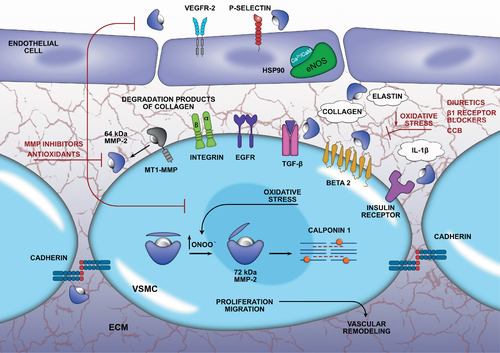Figures & data
Figure 1 Increased MMP-2 activity and the proteolysis of ECM and non-ECM components in the VSMC. Increased MMP-2 activity contributes to hypertension-induced maladaptive vascular remodeling as it degrades many ECM and non-ECM components in the VSMC. MMP-2 is activated by MT1-MMP in the ECM, where it degrades collagen and elastin. The cleaved products of collagen interact with the integrin receptors in the VSMC and activate the focal adhesion kinase signaling, which stimulates migration and proliferation. In the ECM, MMP-2 also processes the latent TGF-β to facilitate VSMC migration and the β2 adrenergic and insulin receptors, which leads to vasoconstriction. MMP-2 may also cleave cadherin between VSMC. The activation of MMP-2 by oxidative stress may contribute to proteolysis of calponin-1 in the machinery of VSMC, thus resulting in migration or proliferation. In the endothelial cells, MMPs may cleave the VEGFR-2 and P-selectin, and then participate in many inflammatory processes in the vasculature during hypertension. HSP90 and eNOS may be potential targets of MMP-2 in endothelial cells, thus contributing to hypertension-induced vascular endothelial dysfunction. Finally, MMP-2 also cleaves the IL-1β that increases reactive oxygen species and increases proliferation in VSMC. The use of antioxidants and some anti-hypertensive drugs also reduces increased MMP-2 activity by decreasing oxidative stress in the VSMC.

